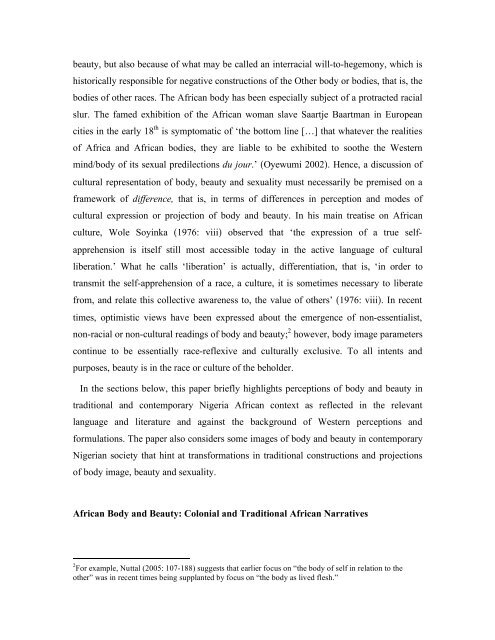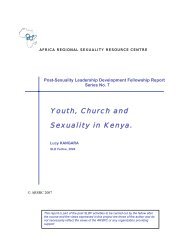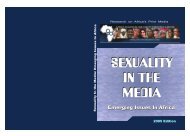body images beauty culture and language - Africa Regional ...
body images beauty culture and language - Africa Regional ...
body images beauty culture and language - Africa Regional ...
You also want an ePaper? Increase the reach of your titles
YUMPU automatically turns print PDFs into web optimized ePapers that Google loves.
eauty, but also because of what may be called an interracial will-to-hegemony, which is<br />
historically responsible for negative constructions of the Other <strong>body</strong> or bodies, that is, the<br />
bodies of other races. The <strong>Africa</strong>n <strong>body</strong> has been especially subject of a protracted racial<br />
slur. The famed exhibition of the <strong>Africa</strong>n woman slave Saartje Baartman in European<br />
cities in the early 18 th is symptomatic of ‘the bottom line […] that whatever the realities<br />
of <strong>Africa</strong> <strong>and</strong> <strong>Africa</strong>n bodies, they are liable to be exhibited to soothe the Western<br />
mind/<strong>body</strong> of its sexual predilections du jour.’ (Oyewumi 2002). Hence, a discussion of<br />
cultural representation of <strong>body</strong>, <strong>beauty</strong> <strong>and</strong> sexuality must necessarily be premised on a<br />
framework of difference, that is, in terms of differences in perception <strong>and</strong> modes of<br />
cultural expression or projection of <strong>body</strong> <strong>and</strong> <strong>beauty</strong>. In his main treatise on <strong>Africa</strong>n<br />
<strong>culture</strong>, Wole Soyinka (1976: viii) observed that ‘the expression of a true self-<br />
apprehension is itself still most accessible today in the active <strong>language</strong> of cultural<br />
liberation.’ What he calls ‘liberation’ is actually, differentiation, that is, ‘in order to<br />
transmit the self-apprehension of a race, a <strong>culture</strong>, it is sometimes necessary to liberate<br />
from, <strong>and</strong> relate this collective awareness to, the value of others’ (1976: viii). In recent<br />
times, optimistic views have been expressed about the emergence of non-essentialist,<br />
non-racial or non-cultural readings of <strong>body</strong> <strong>and</strong> <strong>beauty</strong>; 2 however, <strong>body</strong> image parameters<br />
continue to be essentially race-reflexive <strong>and</strong> culturally exclusive. To all intents <strong>and</strong><br />
purposes, <strong>beauty</strong> is in the race or <strong>culture</strong> of the beholder.<br />
In the sections below, this paper briefly highlights perceptions of <strong>body</strong> <strong>and</strong> <strong>beauty</strong> in<br />
traditional <strong>and</strong> contemporary Nigeria <strong>Africa</strong>n context as reflected in the relevant<br />
<strong>language</strong> <strong>and</strong> literature <strong>and</strong> against the background of Western perceptions <strong>and</strong><br />
formulations. The paper also considers some <strong>images</strong> of <strong>body</strong> <strong>and</strong> <strong>beauty</strong> in contemporary<br />
Nigerian society that hint at transformations in traditional constructions <strong>and</strong> projections<br />
of <strong>body</strong> image, <strong>beauty</strong> <strong>and</strong> sexuality.<br />
<strong>Africa</strong>n Body <strong>and</strong> Beauty: Colonial <strong>and</strong> Traditional <strong>Africa</strong>n Narratives<br />
2 For example, Nuttal (2005: 107-188) suggests that earlier focus on “the <strong>body</strong> of self in relation to the<br />
other” was in recent times being supplanted by focus on “the <strong>body</strong> as lived flesh.”






